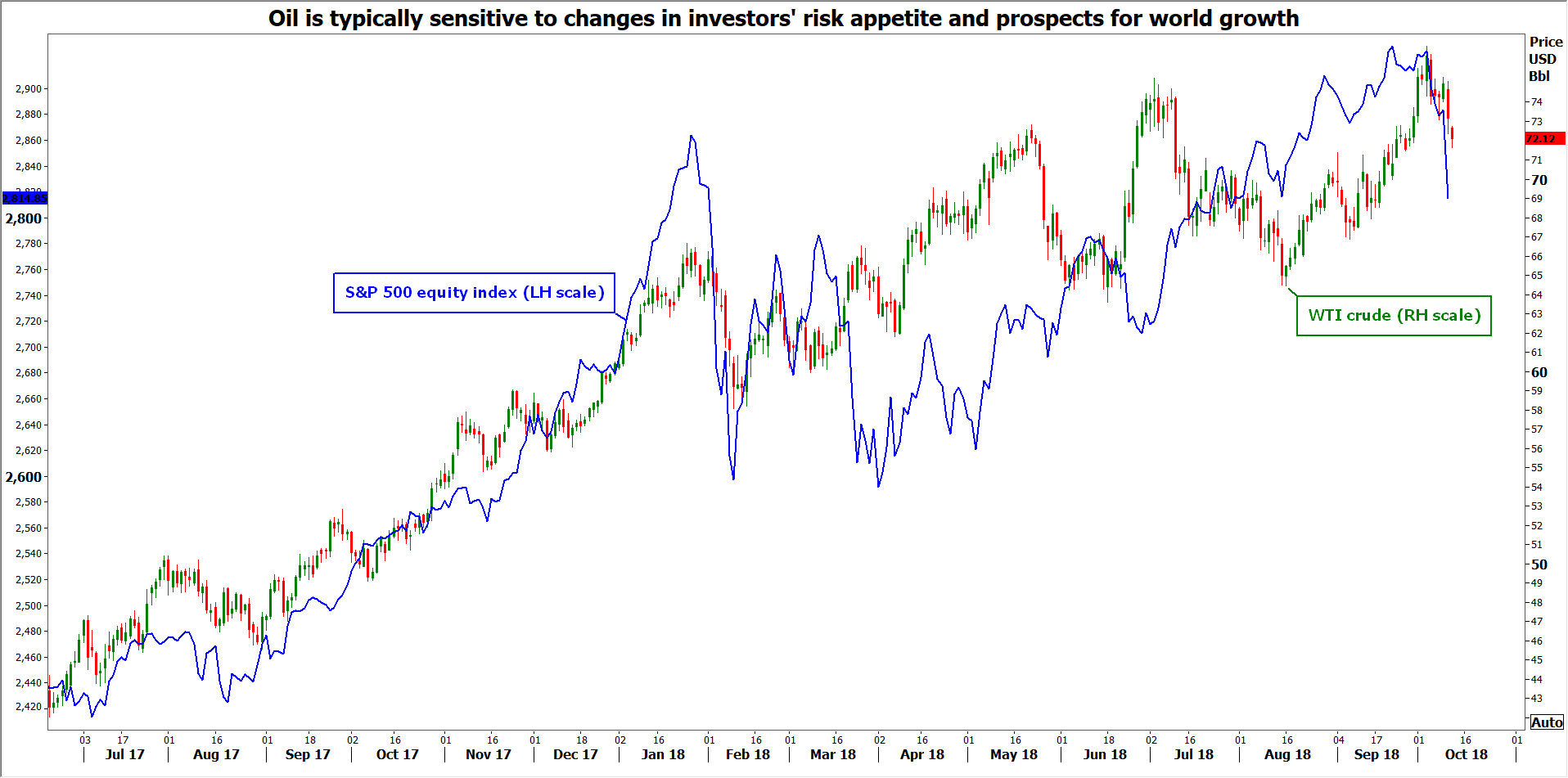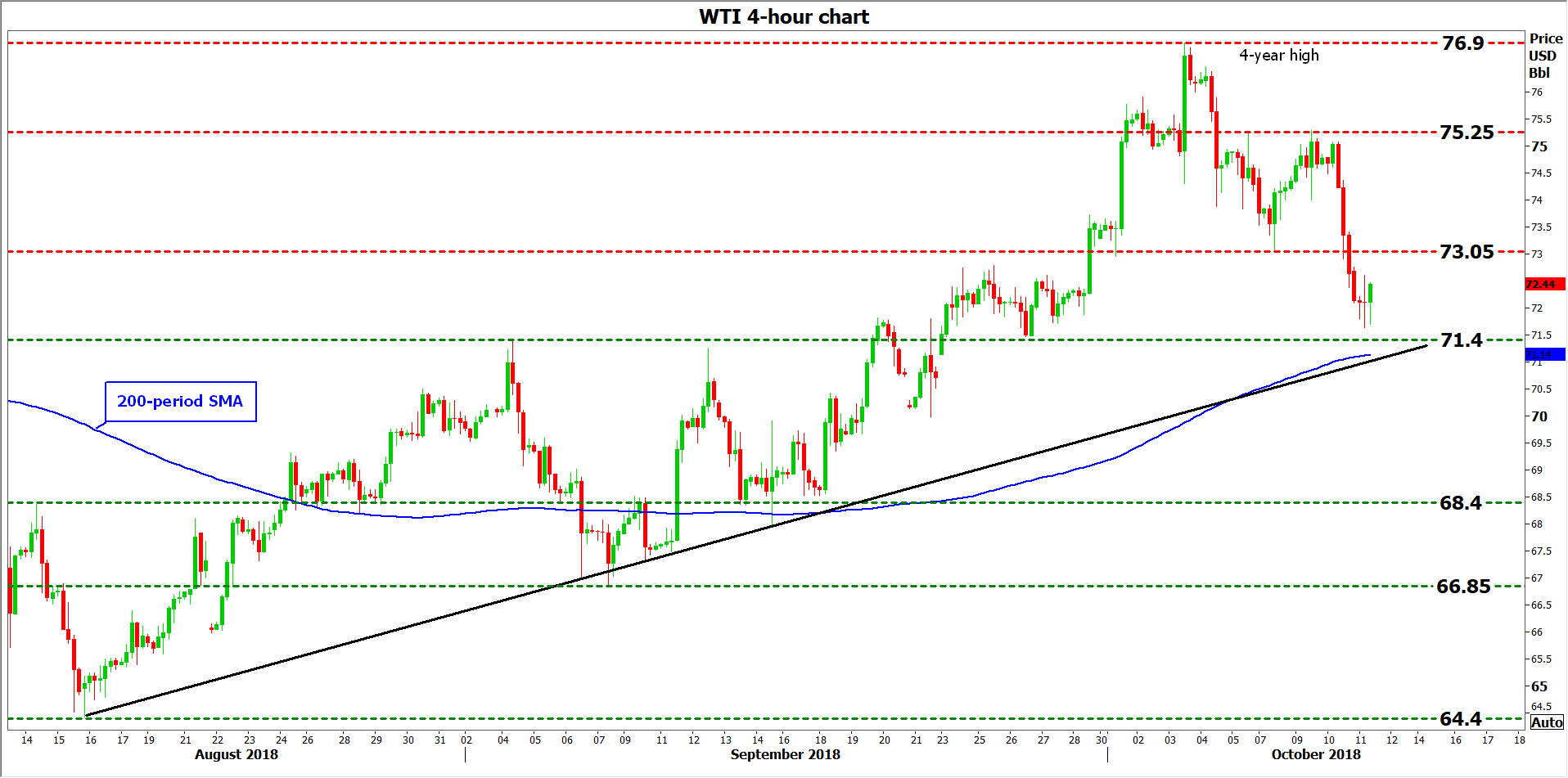Crude oil prices have pulled back in recent days, unable to capitalize on hurricane-related supply disruptions in the US, as the broad-based risk aversion in the markets and concerns over a potential slowdown in China dwarfed everything else. For oil to resume its broader rally it may require fresh and major supply disruptions beyond Iran, or a material de-escalation in the Sino-American trade conflict, which currently seems unlikely.
Hurricane Michael hit the United States mainland on Wednesday, making landfall in Florida and leaving a trail of destruction in its wake. Considering the geography of the region, nearly 42% of crude oil production was shut down in the Gulf of Mexico, as companies evacuated offshore drilling rigs. Yet, despite dominating news headlines, the impact on oil prices was modest, at best. This hails from the fact that 42% of the Gulf of Mexico’s lost output equates to merely 6.5% of total US production, hence representing just a “drop in the bucket” in the big picture. The Gulf’s diminishing importance is owed to the surge in onshore shale production in recent years, which has eclipsed offshore drilling in terms of total output.
Separately, the key speculative factor that has pushed prices up in recent months, sanctions on Iran, was downplayed lately by reports suggesting the US is considering whether to grant some countries a waiver. The sanctions will go into full effect on November 4, but Washington has hinted it may temporarily excuse nations that have already begun reducing their trade with Iran, to give them more time to find alternative sellers.
Turning to the demand side, risk aversion engulfed markets in recent sessions, curbing appetite for riskier assets and commodities, including oil. Perhaps more importantly, traders appear increasingly nervous around the prospects for Chinese growth, in the midst of an ever-escalating trade conflict. Such concerns are evidently felt among Chinese authorities as well, which eased monetary policy a few days ago and hinted at fiscal stimulus in the pipeline to support the economy, in a sign that they expect a prolonged and possibly damaging trade battle themselves. With China being the world’s largest importer of oil, any material economic slowdown would have sizable consequences for demand and thereby, for prices.
Overall, the above developments cast doubt on recent calls by several pundits for oil prices to rally towards the $100/barrel neighborhood soon. Major and unforeseen supply disruptions – beyond those from Iran that are already well-priced into the market – would probably have to materialize for crude to rally from current levels. Likewise, it may take a de-escalation in Sino-American trade tensions to brighten the outlook for demand and push prices higher, which seems quite unlikely at this stage considering the recent rhetoric from the US and reports of tensions on noneconomic fronts too. In the more immediate-term, oil’s fortunes may hinge mainly on the evolution in investors’ risk sentiment and the performance of equities, given the liquid’s risk-sensitive nature.
Technically, the picture is much brighter, as WTI continues to trade above both a long-term uptrend line drawn from the lows of June 2017, and a short-term upside support line taken from the troughs of August 16. Moreover, the fact that prices recorded a fresh 4-year high last week reaffirms the positive outlook. A potential rebound in WTI could encounter immediate resistance around $73.05, a zone marked by the inside swing low on October 8. An upside break could open the way for the October 9 peak of $75.25, before the 4-year high of 76.90 comes into view.
On the downside, a first line of support to declines may come near the crossroads of the $71.40 area and the uptrend line taken from the lows of August. If the bears manage to pierce it, that would turn the short-term outlook to neutral (from positive), paving the way for a test of the $68.40 hurdle that halted the decline on September 13. Even lower, the September 7 lows of $66.85 would increasingly attract attention.
Forex trading and trading in other leveraged products involves a significant level of risk and is not suitable for all investors.
Recommended Content
Editors’ Picks
EUR/USD edges lower toward 1.0700 post-US PCE

EUR/USD stays under modest bearish pressure but manages to hold above 1.0700 in the American session on Friday. The US Dollar (USD) gathers strength against its rivals after the stronger-than-forecast PCE inflation data, not allowing the pair to gain traction.
GBP/USD retreats to 1.2500 on renewed USD strength

GBP/USD lost its traction and turned negative on the day near 1.2500. Following the stronger-than-expected PCE inflation readings from the US, the USD stays resilient and makes it difficult for the pair to gather recovery momentum.
Gold struggles to hold above $2,350 following US inflation

Gold turned south and declined toward $2,340, erasing a large portion of its daily gains, as the USD benefited from PCE inflation data. The benchmark 10-year US yield, however, stays in negative territory and helps XAU/USD limit its losses.
Bitcoin Weekly Forecast: BTC’s next breakout could propel it to $80,000 Premium

Bitcoin’s recent price consolidation could be nearing its end as technical indicators and on-chain metrics suggest a potential upward breakout. However, this move would not be straightforward and could punish impatient investors.
Week ahead – Hawkish risk as Fed and NFP on tap, Eurozone data eyed too

Fed meets on Wednesday as US inflation stays elevated. Will Friday’s jobs report bring relief or more angst for the markets? Eurozone flash GDP and CPI numbers in focus for the Euro.

